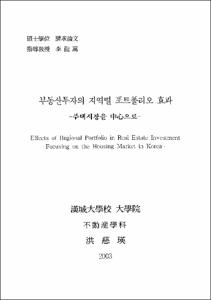부동산투자의 지역별 포트폴리오 효과
= Effects of Regional Portfolio in Real Estate Investment : Focusing on the Housing Market in Korea
- Alternative Title
- 주택시장을 中心으로
- Abstract
- The standards for the investment in real estate are changing. The main investment trend in real estate before the foreign exchange crisis in Korea was investing in real estate with expectations for capital gain. However, the number of investors who focus more on income producing rather than on uncertain capital gain has been on the rise since the foreign exchange crisis that hit Korea in late 1997. As a result, the concept of real estate has shifted from an object for possession to an object for actual use, which resulted in the settlement of the analysis of information in the real estate market as one of the most essential methods.
Due to the specific feature of real estate highly depending on its location, real estate prices and rents are differently formed by area. Accordingly, when investors analyze real estate information, they simply acknowledge the market trends such as changes in real estate prices through television, newspaper, magazines and the Internet, while they do not even have a basis for the general understanding of the overall real estate market. Therefore, the purpose of this study is to know the effectiveness of portfolios when making portfolios with real estate (purchasing prices and rents) differently formed by areas.
This study was aimed at examining portfolio effects when composing investment portfolios with apartments in Seoul, Busan and Dague areas, focused on the analysis of investment profit rates of apartments. In order to conduct the examination, houses were chosen as representative real estate assets in this study. As purchasing price index and jeonse price index of apartments have already been settled well, among apartments, row houses and detached houses that constitute the housing market, apartment index was chosen to be used here due to its advantage of easy estimation of expected profit rates and risks of investment portfolios.
The purpose of this study is to know the effectiveness of portfolios when making portfolios with real properties differently formed by areas. Here I used the method of Bootstrapping Simulation rather than the generally used method of mean-variance criterion in order to estimate expected profit rates and risks of each portfolio. In addition, VAR (Value At Risk) was used besides standard deviations for the evaluation of risks.
As a result of the analysis, investment portfolios with apartments located in Seoul and Busan were effective, as the profit rates of apartments located in the two cities have shown a reversed interrelation. On the other hand, the investment portfolio with apartments in Seoul and Daegu, and another investment portfolio with apartments in Busan and Daegu turned out to be ineffective. This is attributed to the fact that the fluctuations in apartment prices in Daegu area have not shown any clear move, unlike active fluctuations in apartment prices located in Seoul and Busan.
In addition, the investment portfolio effects between Seoul, Busan and Daegu turned out to be vary weak as well. This is also attributed to weak moves in apartment prices located in Daegu. As for Gangnam and Gangbuk areas in Seoul, portfolios of the two areas turned out to be ineffective in terms of risk diversification. Investing in Gangnam area has a tendency of high profits with high risks whereas investing in Gangbuk area is likely to get low profits with low risks. Therefore, those who prefer high profits in spite of high risks would have a strong tendency to invest in Gangnam area, whereas those who are reluctant to take a risk had better invest in Gangbuk area. The reason why the profit rates of the two areas are not showing a reversed interrelation is because the two areas are similar so that the profit rates of the two areas are not moving in reverse directions to each other.
As a result of the analysis on the effects of portfolios when investing in real estate with different specific gravity on each area, for the purpose of estimating portfolio effects of the investment in real estate by area, the portfolio effect on real estate investment appear to be weak in Korea. The weak effectiveness of portfolios on real estate investment by area is attributed to the fact that the profit rates of each area are not showing reversed interrelations, or the degrees of such interrelations are still weak.
- Issued Date
- 2003
- Type
- Thesis
- Files in This Item:
-
-
Download
 000000066197.pdf
기타 데이터 / 1.54 MB / Adobe PDF
000000066197.pdf
기타 데이터 / 1.54 MB / Adobe PDF
-
Items in Repository are protected by copyright, with all rights reserved, unless otherwise indicated.